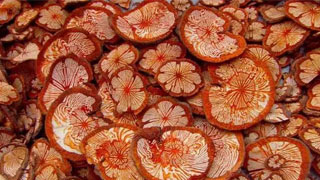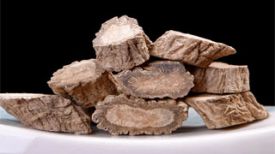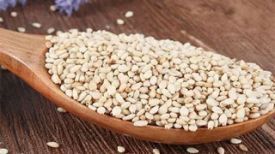
1. Alias
Blood Vine, Red Vine, Blood Activating Vine, Red Vine, Big Blood Activating Vine, Mountain Red Vine.2. Plant morphology
Deciduous woody vine. It can reach a height of up to 10 meters. The stem is brown, striped, smooth, and the old stem has a thick layer of wood plugs. 3 compound leaves, alternate; The petiole is long, with grooves on top, and the middle small leaf is rhomboid ovate in shape. The small leaves on both sides are larger than those in the middle. Racemes axillary, drooping, flowers unisexual, dioecious, bract, flowers numerous, fragrant, male flowers yellow, sepals 6, oblong, petals small, 6, rhomboid round; Female flowers are the same as male flowers, with 6 degenerated stamens, an upper ovary, multiple carpels, detached, and arranged in a spiral pattern. Berry oval shaped. Seed ovate, black, glossy. The flowering period is from March to May, and the fruiting period is from July to September.
3. Origin distribution
Born in sparse forests or shrubs. Distributed in Sichuan, Guizhou, Yunnan and other places.
4. Harvesting and processing
Cut off stems and vines with a diameter of more than 3 centimeters in autumn and winter, remove the branches, cut them into small or thick pieces, and dry them in the sun.
5. Characteristics of medicinal herbs
Cylindrical, slightly curved, measuring 30-60 centimeters in length and 1-3 centimeters in diameter. The surface is gray brown, rough, and the outer skin often peels off in a scale like manner. The peeling area appears dark reddish brown, and some may show enlarged nodes and slightly depressed branch or leaf marks. Hard in texture, with red brown skin on the cross-section, and several areas embedded inward into the wood. The wood is yellow white, with many fine pore shaped conduits and radiating rays. Mild odor and slightly astringent taste.
6. Sexual Taste Returning to the Classics
Flat in nature, bitter in taste. Return to the colon meridian and liver meridian.
7. Effect and Function
Clearing heat and detoxifying, promoting blood circulation and dispelling wind, and relieving pain. A blood activating painkiller classified under the category of blood activating and stasis removing drugs.
8. Clinical application
Dosage: 5-15 grams, decoct or grind into powder, soak in alcohol and take; Apply an appropriate amount externally and massage onto the affected area. Used to treat intestinal abscess, abdominal pain, menstrual cramps, rheumatism, and swelling and pain.
9. Pharmacological research
Animal experiments have shown that water extraction and alcohol precipitation can improve hypoxia tolerance, weaken cardiac contractility, slow down heart rate, reduce cardiac output, alleviate myocardial infarction and ischemia, improve myocardial lactate metabolism disorders caused by myocardial infarction, directly dilate coronary arteries, inhibit gastrointestinal smooth muscle, and also have the effect of lowering blood pressure and increasing cAMP and cGMP levels in the blood.
10. Chemical composition
Containing components such as emodin, emodin methyl ether, carotenoids, β - sitosterol, stearic acid, salidroside, aucubin, tannins, etc.
11. Usage taboos
Pregnant women should take it with caution.
12. Compatibility prescription
① Treatment of dysmenorrhea: 9-15 grams each of red vine, motherwort, and dragon bud grass. Boil it in water. (Zhejiang Medicinal Plant Chronicles)
② Treating Blood Collapse: 15 grams each of Red Vine, Crane Grass, and Grass Root. Boil it in water. (Hunan Pharmaceutical Journal)
③ Treat injuries caused by falls: appropriate amounts of Da Xue Teng and Gu Duan Bu. Crush and apply to the injured area. (Handbook of Commonly Used Chinese Herbal Medicines in Rural Hunan)
④ Treatment for rheumatism, lower back and leg pain: 9 grams each of red vine and Achyranthes bidentata, 6 grams each of Qingpi, Changchun Seven, and cinnabar Seven. Boil it in water. (Shaanxi Chinese Herbal Medicine)
⑤ Treat gastrointestinal problems
⊙ The content of the article is for clinical reference only. Non TCM professionals are not allowed to test drugs.


